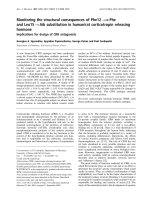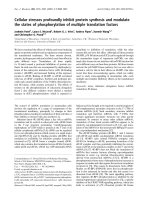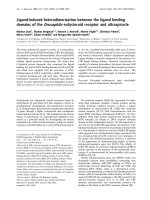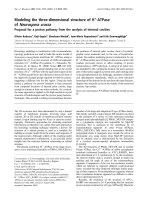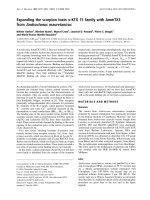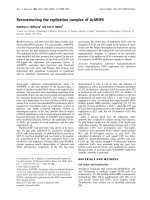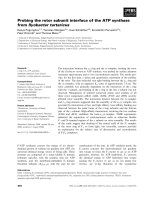Báo cáo y học: "How the relationships between general practitioners and intensivists can be improved: the general practitioners'''' point of view" ppt
Bạn đang xem bản rút gọn của tài liệu. Xem và tải ngay bản đầy đủ của tài liệu tại đây (584.58 KB, 9 trang )
Etesse et al. Critical Care 2010, 14:R112
/>Open Access
RESEARCH
© 2010 Etesse et al.; licensee BioMed Central Ltd. This is an open access article distributed under the terms of the Creative Commons
Attribution License ( which permits unrestricted use, distribution, and reproduction in
any medium, provided the original work is properly cited.
Research
How the relationships between general
practitioners and intensivists can be improved: the
general practitioners' point of view
Bérengère Etesse
1
, Samir Jaber
2
, Thibault Mura
3
, Marc Leone
4
, Jean-Michel Constantin
5
, Pierre Michelet
6
, Lana Zoric
1
,
Xavier Capdevila
7
, François Malavielle
1
, Bernard Allaouchiche
8
, Jean-Christophe Orban
9
, Pascale Fabbro-Peray
3
, Jean-
Yves Lefrant*
1
for the AzuRéa Group
Abstract
Introduction: The present study assessed the opinion of general practitioners (GPs) concerning their relationships
with intensivists.
Methods: An anonymous questionnaire was mailed to 7,239 GPs. GPs were asked about their professional activities,
postgraduate intensive care unit (ICU) training, the rate of patient admittance to ICUs, and their relationships with
intensivists. Relationship assessment was performed by using a graduated visual analogue scale (VAS) ranging from 0
(dissatisfaction) to 100 (satisfaction). A multivariate analysis with stepwise logistic regression was performed to isolate
factors explaining dissatisfaction (VAS score, < 25
th
percentile).
Results: Twenty-two percent of the GPs (1,561) responded. The median satisfaction score was 57 of 100 (interquartile
(IQ), 35 to 77]. Five independent factors of dissatisfaction were identified: no information provided to GPs at patient
admission (odds ratio (OR) = 2.55 (1.71 to 3.80)); poor quality of family reception in the ICU (OR = 2.06 (1.40 to 3.02)); the
ICU's family contact person's identity or function or both is unclear (OR = 1.48 (1.03 to 2.12)), lack of family information
(OR = 2.02 (2.48 to 2.75)), and lack of discharge report (OR = 3.39 (1.70 to 6.76)). Three independent factors prevent
dissatisfaction: age of GPs ≤45 years (OR = 0.69 (0.51 to 0.94)); the GP is called at patient ICU admission (OR = 0.44 (0.31
to 0.63)); and GP involvement in treatment decisions (OR = 0.17 (0.07 to 0.40)).
Conclusions: Considerable improvement in GP/intensivist relationships can be achieved through increased
communication measures.
Introduction
Because the general practitioner (GP) is a cornerstone of
the daily life of the patient and all specialties of the hospi-
tal, he or she should be a main communicator with ICU
physicians. At patient admission, the GP is the sole medi-
cal practitioner who knows the patient's history and his
or her way of life. This information could be of particular
interest for therapeutic and ethical decisions. In intensive
care units (ICUs), GP involvement in the process of fam-
ily communication is an independent factor of satisfac-
tion among patients' relatives experiencing depression
and posttraumatic stress disorder [1-3]. After patient
hospital discharge, the sequelae of an ICU stay in a
patient's way of life can be severe and prolonged [4,5].
One year after acute respiratory distress syndrome
(ARDS), a significant portion of patients have not
returned to their previous jobs [4]. For all of these rea-
sons, ICU physicians should optimize their relationships
with GPs. However, these relationships are poorly
described. In a recent study, 245 intensivists from ICUs in
southern France were questioned by phone concerning
their relationships with GPs [6]. An informative letter
from the GP to the hospital physician was reported for
only 20% of admitted patients, and 50% of these letters
were considered uninformative. However, only 33% of the
* Correspondence:
1
Division Anesthésie Réanimation Douleur Urgences, Groupe Hospitalo-
Universitaire Caremeau, Centre Hospitalier Universitaire Nîmes, Place du
Professeur Robert Debré, 30029 Nîmes Cedex 9, France
Full list of author information is available at the end of the article
Etesse et al. Critical Care 2010, 14:R112
/>Page 2 of 9
intensivists reported contacting designated GPs after
patient admission. The lack of informative letters at
patient admission and the lack of contact between GPs
and intensivists do not reflect good practice. Currently,
no study analyzes the relationship between intensivists
and GPs at patient discharge. In other fields, Westermann
et al. [7] reported delayed information by specialists (39
to 46 days after the patient's consultation). Long et al. [8]
sent a questionnaire to 80 consultants at four hospitals in
southeast England and to 100 GPs in the same area. Only
3% of consultants contacted GPs to inform them during
the same period. In a postal survey sent from an emer-
gency department to 380 GPs, 147 (39%) responders
reported deficiencies in the discharge information and
substantial difficulties in accessing outstanding investiga-
tion results [9]. In an ENT emergency department, Was-
son et al. [10] showed that the use of a computerized
clinic letter template improves communication with ENT
emergency clinic patients' general practitioners. More-
over, adequate communication between emergency
departments and GPs (using a referral letter) has been
shown to be cost effective, with $2,600 saved per month
[11].
Two intuitive reasons could explain the lack of direct
contact between GPs and intensivists. First, most patients
are transferred to the ICU from another department.
Hence, the GPs are not involved in the ICU admission
process. Second, the patients are discharged from the
ICU to ward, but not to their homes. To increase the col-
laboration between intensivists and GPs, the present
study aimed at assessing the opinions of GPs about their
relationships with intensivists.
Materials and methods
The present study was approved by the Comité Consul-
tatif de Protection des Personnes en matière de Recher-
che Biomédicale (February 18, 2005, Comité Sud-
Méditerranée, n° 05.39). Funding was provided by grants
from the French national programme, Projet Hospitalier
de Recherche Clinique.
Design
In this epidemiologic, transversal, descriptive study, an
anonymous questionnaire was mailed between June 1
and July 31, 2006, to GPs in four areas of southeastern
France (Bouches du Rhône, Hérault, Vaucluse, and Gard).
GP addresses were provided by the different French Med-
ical Councils [conseils départementaux de l'ordre des
médecins]. In this study, most of GPs were physicians
with ≥2 years of residency after the end of their medical
studies.
Questionnaire description
The questionnaire was created and validated by a Survey
Committee (five intensivists (BE, SJ, PM, JMC, and JYL)
and two epidemiologists (TM and PFP)) and was divided
into five parts (English version in Additional file 1).
Professional characteristic of GPs
Every GP was asked about his or her gender, age range (25
to 35 years; 36 to 45 years; 46 to 55 years; or > 55 years),
first medical school, date of degree certification, onset of
professional activity, working area, population of working
city, and distance between their office and the nearest
university hospital ICU. In addition, information con-
cerning the number of patients per year, the way medical
information related to the patient was collected (health
book, health card, computer, or none), and continuing
medical education sessions was requested.
Intensive care training
Every GP was asked about university, postgraduate ICU
training including specific areas (cardiac arrest resuscita-
tion; central venous catheter insertion; tracheal intuba-
tion; miscellaneous; none; and frequency of the use of
ICU abilities).
The relationship at admission and during the patient's stay in
ICU
Every GP was asked about the rate of patient admission to
the ICUs per year, the way they were informed of patient
ICU admission (patient's relatives; intensivists; or no
information), their communication channels during the
ICU stay (visit; phone call; relatives; or hospitalization
discharge report), and their contact during ICU visits
(intensivist, nurse, or resident). Moreover, every GP was
asked about the occurrence of a GP/relative meeting dur-
ing the patient ICU stay (frequency and the aim of these
meetings). The frequency of reception of an ICU report
was estimated.
GPs' wishes
General practitioners were asked about their wishes con-
cerning the mode of communication at patient ICU
admission (letter, phone call, or e-mail) and their level of
involvement in treatment decisions.
Global assessment of the relationship
At the end of the questionnaire, the relationship was
assessed by using a graduated visual analogue scale rang-
ing from 0 (dissatisfaction) to 100 (satisfaction).
Mailing
The questionnaires were sent with a stamped return
envelope to the address of the principal investigator. The
questionnaires were sent only once (that is, no reminders)
to keep the GP's identity anonymous, despite the risk of
decreasing the response rate. A letter written by the pres-
ident of each Medical Council was joined to the question-
naire to encourage GP response. Responses were
collected up to the 31 December, 2006.
Data collection
Data were collected by using Microsoft Excel and for-
warded to the medical information department of Nîmes
Etesse et al. Critical Care 2010, 14:R112
/>Page 3 of 9
University Hospital, Nîmes, France. Statistical analysis
was performed by using SAS/STAT 8.1 software (SAS
Institute, Cary, NC, USA).
Quantitative variables were expressed as means (±
standard deviation) or medians with interquartiles (IQs)
according to their distributions. Qualitative variables
were expressed as numbers and percentages (total can
slightly differ from 100% because of rounding).
General practitioner's dissatisfaction was defined by a
global score lower than the first quartile. The populations
of the first and remaining quartiles were then compared
by univariate analysis with χ
2
, Student t, or Wilcoxon
tests, as appropriate. When a P value was < 0.20, the cor-
responding parameter was entered into a multivariate
analysis with stepwise logistic regression to isolate princi-
pal explanatory factors of dissatisfaction. The best model
was selected by Wald tests, with a statistical significance
< 0.05. Finally, the odds ratios were expressed with a 95%
confidence interval (95% CI).
Results
One thousand five hundred sixty-one (22%) GPs
responded. Most of them were men aged 45 years or
older. Table 1 shows the professional status of the GPs.
Half of the GPs worked in a city with > 20,000 inhabit-
ants. The nearest ICUs were within 25 km of the working
city for 90% of GPs, whereas university hospitals were
within that range for only 54% of GPs. Sixty-nine percent
of GPs used computers for storing patient data, and 68%
regularly attended training courses. However, 474 (30%)
responders indicated that they had no experience with
resuscitation maneuvers.
GP-intensivist relationships at admission and during ICU
stay
According to the opinion of 1,097 (70%) GPs, at least two
of "their" patients are admitted to the ICU per year. Sixty-
five percent of the GPs reported to have had no informa-
tion at patient admission (Table 2). When the GPs were
informed, information sources included the family (72%)
and the intensivists (39%). During the patient's stay, GPs
collected information by phone. Thirty-one percent of
the GPs reported that the discharge letter was the only
contact with the ICU team. Ninety-three percent of the
GPs reported meeting the family during the patient's ICU
stay (more than one meeting for 47%). A lack of informa-
tion (36%) and the poor quality of information (85%) were
the two major reasons for the patient's family to meet the
GP.
GP and intensivist relationships at patient discharge
Fifty-nine percent of the GPs (897) reported that they
were never involved in the treatment decisions concern-
ing their patients. Only 35 (2%) were contacted for all
decisions. Fifty percent of the GPs (758) received a clini-
cal report of the ICU hospitalization for each of their
patients. When the report was sent, 88% (1,334) of the
GPs claimed to read it entirely.
Global satisfaction and dissatisfaction factors
By using the visual analogue scale, GP satisfaction with
the relationship with intensivists reached a median score
of 57 (of 100; IQ, 35 to 77). Therefore, the dissatisfaction
was defined as a VAS score < 25
th
percentile, i.e. ≤35/100.
The factors associated with GP dissatisfaction are given
in Tables 3 and 4. After logistic regression, five indepen-
dent factors related to GP dissatisfaction were found: no
information sent to GPs at patient ICU admission (OR =
2.55 (1.71 to 3.80)), poor family reception in the ICU (OR
= 2.06 (1.40 to 3.02)), the ICU's family-contact person's
identity or function or both was unclear (OR = 1.48 (1.03
to 2.12)), lack of information for the family (OR = 2.02
(1.48 to 2.75)), and lack of an ICU report at patient dis-
charge (OR = 3.39 (1.70 to 6.76)). In contrast, three inde-
pendent factors prevent GP dissatisfaction: GP age
younger than 45 years (OR = 0.69 (0.51 to 0.94)), informa-
tion sent to the GPs by the ICU team at patient admission
(OR = 0.44 (0.31 to 0.63)), and involvement of the GPs in
treatment decisions (OR = 0.17 (0.07 to 0.40)).
How GPs would like to improve their relationships with
intensivists
The main wishes of GPs concerning their patient's ICU
stay were to be informed of patient ICU admission, pref-
erably by a phone call, and to be involved in the treatment
decisions (Table 5). They would also like the following
items to appear in the ICU report: primary diagnosis,
adverse events, treatments, and patient management at
discharge.
Discussion
In this study reporting the opinions of 1,561 of 7,239 GPs
who responded to a questionnaire focused on their rela-
tionships with intensivists, GPs blamed intensivists for a
lack of information at patient admission and discharge
and wished to be involved in treatment decisions.
We sent a questionnaire to 7,239 GPs located in the
south of France. No recall was performed to favor the
anonymity of the responders. This led to 1,561 responses,
corresponding to a response rate of 22%. In comparison,
Marshall et al. [12] used a recall method and obtained
606 responses of 800 anonymous questionnaires sent
(response rate, 76%). In the present study, 25% of
responders assessed their relationship with intensivists at
a score < 35 of 100. This high rate of dissatisfaction
among responders indicates that much effort is required
to improve GP/intensivist relationships. Because of the
moderate response rate, the findings of the present study
Etesse et al. Critical Care 2010, 14:R112
/>Page 4 of 9
Table 1: Professional status
Number (%) Missing data
Seniority since thesis (years) (median, (IQ)) 22 (15 to 28) 10
Seniority at work (years) (median, (IQ)) 20 (13 to 26)
Size of the working city 17
< 1,000 inhabitants (n, %) 53 (3)
1,000 to 5,000 343 (23)
5,000 to 20,000 343 (23)
20,000 to 50,000 214 (14)
50,000 to 100,000 102 (7)
> 100,000 489 (32)
Distance from the nearest ICU 14
< 10 km 973 (63)
10 to 25 km 413 (27)
25 to 50 km 149 (9)
> 50 km 21 (1)
Distance from the nearest university
hospital
13
< 10 km 536 (35)
10 to 25 km 289 (19)
25 to 50 km 333 (22)
> 50 km 390 (25)
Number of patients per year 129
< 50 44 (3)
50 to 100 111 (8)
100 to 200 135 (9)
200 to 500 192 (13)
500 to 1,000 479 (33)
> 1,000 471 (33)
Storing medical information
Computer 1,075 (69)
Health book 582 (37)
Health card 74 (50)
None 16 (1)
Training courses during university
and postgraduate studies 1,111 (68)
Training in ICU procedures
Cardiac-arrest resuscitation 984 (63)
Central venous cannulation 361 (23)
Orotracheal intubation 577 (37)
None 474 (30)
ICU, intensive care unit; IQ, interquartile; MD, missing data.
Etesse et al. Critical Care 2010, 14:R112
/>Page 5 of 9
could under- or overestimate the real opinion of the
entire GP population. We cannot determine whether
responders aimed at expressing their special interests or
conflicts with ICU practices. This lack of information
concerning non responders could obtund the analysis.
Moreover, as the questionnaire was anonymous, we can-
not assess the impact of the practices of the closest ICU
on the GP's assessment. Each ICU's visiting policy, that is,
their usual communication route with the GP, could
influence both family and GP satisfaction. In addition, the
studied population may not be representative of the
French GP population. The 1,561 responders correspond
to only 1.46% of the 106 697 GPs registered in the French
National Medical Registry in 2004 [13]. However, the
characteristics of the responders tend to be similar to
those of the overall French GP population: 64% of GPs
were older than 45 years, and more women GPs were in
the young range (≤35 years old, 50%; 36 to 45, 45%; 46 to
55, 27%; and older than 55 years: 12% (data not shown))
[14]. No extrapolation to other European countries can
be made because the national organization of each coun-
try could alter the role of GPs as regards patient care and
the GPs' assessment of their relationships with intensiv-
ists. Despite these potential limitations, the present study
is the largest one ever focused on this subject.
Table 2: Information flow to general practitioners at intensive care unit admission and stay
Number (%) Missing data
At patient admission (several possible answers)
By family 1,121 (72)
By ICU 610 (39)
By colleagues 108 (7)
No information 1,010 (65)
During hospitalization (several possible answers)
Visiting ICU 273 (17)
Meeting with relatives 216 (14)
Phone call 1,042 (67)
Hospitalization report 480 (31)
Interviewer for visit in ICU 79
Senior/junior 662 (45)
Only senior 167 (11)
Nurse 6 (0.4)
Whoever 647 (47)
Meeting between GPs and relatives 46
Never 118 (8)
Once 661 (44)
More than once 736 (49)
Family reasons for meeting (several possible answers) 46
No information 559 (36)
Incomprehensive information 1,320 (85)
Bad reception in ICU 236 (15)
Unknown identity or function of interlocutor 297 (19)
The family trusts the GP 424 (27)
ICU, intensive care unit; MD, missing data.
Etesse et al. Critical Care 2010, 14:R112
/>Page 6 of 9
Despite recommendations favoring GP/specialist rela-
tions, few studies have reported the actual relationships
between these two caregivers. As concerns information
exchange between GPs and specialists, Westermann et al.
[7] reported a lack of information in GP letters (for exam-
ple, the primary diagnosis or concern for the patient was
missing in nearly half of the letters), as well as delayed
responses by specialists (39 to 46 days after patient con-
sultation). In another study, Long et al. [8] sent a ques-
tionnaire to 80 consultants working for four hospitals in
southeast England and to 100 GPs in the same area. Only
2% of the GPs contacted (letter, phone, or visiting) the
consultant after patient admission, and only 3% of consul-
tants contacted GPs for communication purposes during
the same period. After questioning 21 Danish GPs, Ber-
endsen et al. [15] concluded that a closer relationship
between GPs and specialists may improve patient man-
agement. To our knowledge, GP/intensivist relations have
rarely or never been investigated. We recently questioned
245 intensivists in southern French ICUs by phone con-
cerning their relationships with GPs [6]. An admission
letter from the GP was reported for only 20% of the ICU
patients, whereas only 33% of intensivists reported get-
ting in touch with GPs. The former finding was con-
firmed in the present study because GPs reported that the
ICU team informed them of patient admission in only
39% of cases. This lack of information was independently
associated with GP dissatisfaction. A similar conclusion
was found concerning the relationship between the emer-
gency department and GPs. Montalto et al. [16] reported
that the letters sent to GPs after a consultation in the
emergency department were not informative enough. A
lack of crucial information also was reported by 44% of
GPs with regard to the correspondence from emergency
departments [9]. The lack of information flow to the GPs
Table 3: Factors associated with general practitioner dissatisfaction
Note, ≤35/100
Number (%)
Note, >35/100
Number (%)
Univariate analysis
P value
Multivariate analysis
Odds ratio (CI, 95%)
Age younger than 45 years 120/379 (32) 428/1,116 (38) 0.001 0.69 (0.51 to 0.94)
Intensive care training
Second cycle 137/380 (36) 448/1,121 (40) 0.18
Third cycle 124/380 (33) 309/1,121 (28) 0.059
Never 137/380 (36) 365/1,121 (33) 0.21
Information flow at admission
Information/family 307/380 (81) 783/1,121 (70) < 0.001
Information/ICU 68/380 (18) 532/1,121 (47) < 0.001 0.44 (0.31 to 0.63)
Information/colleagues 14/380 (4) 89/1,121 (8) 0.005
No information 322/380 (85) 658/1,121 (60) < 0.001 2.55 (1.71 to 3.80) (1.71 to 3.80)
Information flow during
hospitalization
Visit in ICU 51/380 (13) 213/1,121 (19) 0.014
Meeting with relatives 66/380 (17) 139/1,121 (12) 0.015
Phone conversation 241/380 (63) 778/1,121 (70) 0.03
Reasons for meetings between
GPs and relatives
No information 194/380 (51) 351/1,121 (31) < 0.001 2.02 (1.48 to 2.75)
Bad reception in ICU 99/380 (26) 133/1,121 (12) <0.001 2.06 (1.40 to 3.02)
Unknown interlocutor 102/380 (27) 192/1,121 (17) <0.001 1.48 (1.03 to 2.12)
Relatives trust the GP 116/380 (30) 300/1,121 (26) 0.156
ICU, intensive care unit.
Etesse et al. Critical Care 2010, 14:R112
/>Page 7 of 9
of ICU patients could lead to the dissatisfaction of the
patients' relatives [1].
In daily clinical practice, the present study demon-
strates that GP/intensivist relationships should be
improved. According to the wishes of the GPs questioned
in this study, the following recommendations can be
made: a systematic phone call to GPs at patient ICU
admission, continuing improvement of patient relative
reception and information flow, the participation of GPs
in treatment decisions, especially concerning end-of-life
decisions, and conveying information to GPs at patient
discharge through a short hospitalization report includ-
ing the reason for admission, the primary diagnosis, and
the treatment. The impact of systematic and complete
conveyance of information to the patient's GP remains to
be studied. Improving the quality of information flow to
patients' relatives decreases the psychological conse-
quences, such as anxiety and/or depression [17]. In the
present study, improving the information flow to relatives
in the ICU could decrease the psychological impact, with
potentially fewer visits to GPs by relatives.
The third point has been well explored, especially
regarding end-of-life decisions [1,17,18]. This could be of
particular importance in France, as half of families do not
want to participate in end-of-life decisions [19]. More-
over, the participation of GPs in treatment decisions,
especially concerning end-of-life decisions, could prevent
the occurrence of posttraumatic stress disorder in family
members because GPs remain close to them after patient
discharge and/or death. In this sense, GPs could also act
as diagnostic screeners for this syndrome.
The fourth point has been studied in emergency
departments. Afilalo et al. [20] showed that the use of a
standardized community system between family GPs and
emergency departments increases the quality of trans-
ferred information and improves the GP's perceived
patient knowledge and patient management. This kind of
information has been shown to be preferred to written
letters [10].
However, the efficiency of such practices requires fur-
ther assessment. The implementation of such practices
cannot be envisaged without a close collaboration
between GP organizations, Medical Councils, and Hospi-
tals.
Conclusions
The present study shows that GP/intensivist relationships
should be improved. Five independent factors of dissatis-
faction were identified: no information provided to GPs
at patient admission, poor quality of family reception in
the ICU, the ICU's family-contact person's identity and/
or function is unclear, lack of family information, and lack
Table 4: Other factors associated with general practitioner dissatisfaction
Note, ≤35/100
Number (%)
Note, > 35/100
Number (%)
Univariate analysis
P value
Multivariate analysis
Odds ratio (CI, 95%)
Reception of hospitalization report < 0.001
Each patient 118/378 (31) 622/1,102 (56) 1 (reference)
More than one patient of two 128/378 (34) 137/1,102 (12) 3.02 (2.04 to 4.46)
Fewer than one patient of two 104/378 (28) 316/1,102 (29) 1.43 (0.99 to 2.06)
No patient 28/378 (7) 27/1,102 (2) 3.39 (1.70 to 6.76)
Hospitalization report reading 0.117
Precise/in depth 315/363 (87) 982/1,103 (89)
Rapid scanning 43/363 (12) 106/1,103 (10)
Conclusion only 2/363 (0.5) 13/1,103 (1)
Never 3/363 (1) 2/1,103 (0.2)
Association of GPs with treatment choices/
decisions
< 0.001
Never 292/378 (77) 572/1,101 (52) 1 (reference)
Sometimes 7/378 (2) 159/1,101 (14) 0.17 (0.07 to 0.40)
Rarely 77/378(20) 337/1,101 (31) 0.47 (0.32 to 0.67)
Always 2/378(1) 33/1,101 (3) 0.72 (0.15 to 3.33)
ICU, intensive care unit.
Etesse et al. Critical Care 2010, 14:R112
/>Page 8 of 9
Table 5: General practitioner wishes during patient intensive care unit stays
Number % Missing data
Information at ICU admission 16
Yes 1,460 (95)
No 32 (2)
No opinion 53 (3)
Mode of information (several possible answers) 16
Phone call 1,107 (71)
Mail 565 (36)
Email 501 (32)
Association with treatment decisions
Always 116 (7)
When intensivists consider it useful 897 (57)
Termination of life-sustaining treatment 229 (15)
No 342 (22)
GP wishes concerning the hospitalization report 37
Current form 840 (55)
Summary 684 (45)
Exhaustive 56 (4)
Hospitalization report contents (several possible answers)
Reason for admission 1,116 (71)
Summarized evolution 972 (62)
Daily precise evolution 134 (9)
Further survey 920 (59)
Adverse events 923 (59)
Duration of hospitalization 589 (38)
Out treatment 1,042 (67)
Transfusion information 652 (42)
Key words 382 (24)
Primary diagnosis 1,151 (74)
ICU hospitalization report in the patient's health book 53
Yes 1,416 (94)
No 92 (6)
of a discharge report. Three independent factors are neg-
atively related to GP dissatisfaction (GP age of 45 years or
younger, telephone call to the GP at patient ICU admis-
sion, and GP involvement in treatment decisions). In con-
clusion, following the simple recommendations proposed
may improve GP/intensivist relationships. Further stud-
ies are required to assess actual improvement in GP/
intensivist attitudes, and how such improvement affects
patient well-being.
Key messages
• 25% of general practitioners assessed their relationship
with intensivists with a score ≤35 of 100.
Etesse et al. Critical Care 2010, 14:R112
/>Page 9 of 9
• Five independent factors of dissatisfaction were iden-
tified: no information provided to GPs at patient admis-
sion, poor quality of family reception in the ICU, the
ICU's family-contact person's identity and/or function is
unclear, lack of family information, and lack of discharge
report.
• Three independent factors prevent dissatisfaction: age
of GPs 45 years or younger, the GP is called at patient
ICU admission, and GP involvement in treatment deci-
sions.
Additional material
Abbreviations
ARDS: Acute Respiratory Distress Syndrome; CI: confidence interval; GP: general
practitioner; ICU: intensive care unit; IQ: interquartile; OR: odds ratio; VAS: visual
analogue scale.
Competing interests
The authors declare that they have no competing interests.
Authors' contributions
All authors have made substantial contributions to conception and design (BE,
SJ, PM, XC, PFP, JYL) or acquisition of data, or analysis and interpretation of data
(BE, TM, FM, PFP, JYL) and/or have been involved in drafting the manuscript or
revising it critically for important intellectual content and/or have given final
approval of the version to be published (BE, SJ, TM, ML, JMC, PM, LZ, XC, FM, BA,
JCO, PFP, JYL).
Acknowledgements
The authors thank all GPs who generously gave of their own time to respond
to the questionnaire. We also give special thanks to Dr. Carey Suehs for her help
with English corrections.
Author Details
1
Division Anesthésie Réanimation Douleur Urgences, Groupe Hospitalo-
Universitaire Caremeau, Centre Hospitalier Universitaire Nîmes, Place du
Professeur Robert Debré, 30029 Nîmes Cedex 9, France,
2
Service d'Anesthésie
Réanimation B, CHU Saint Eloi, 2 av Emile Bertin Sans, 34000 Montpellier,
France,
3
Département d'Information Médicale, Groupe Hospitalo-Universitaire
Caremeau, Centre Hospitalier Universitaire Nîmes, Place du Professeur Robert
Debré, 30029 Nîmes Cedex 9, France,
4
Service d'Anesthésie et de Réanimation,
Hôpital Nord, Chemin des Bourrely, 13915 Marseille Cedex 20, France,
5
Service
d'Anesthésie Réanimation, Hôpital Hôtel Dieu, Boulevard Léon Malfreyt, 63000
Clermont Ferrand, France,
6
Réanimation des Urgences, Hôpital Saint
Marguerite, 270 Boulevard de Sainte Marguerite 13274 Marseille cedex 9,
France,
7
Service d'Anesthésie Réanimation A, CHU Lapeyronie, 371 av Doyen
Gaston Giraud, 34000 Montpellier, France,
8
Service d'Anesthésie Réanimation,
Service d'Anesthésie Réanimation, Hôpital de la Croix Rousse, 103 Grande Rue
de la Croix Rousse, 69317 Lyon cedex 04, France and
9
Service de Réanimation
Médico Chirurgicale, Hôpital Saint Roch, 5 rue Pierre Devoluy, 06 006 Nice
Cedex, France
References
1. Azoulay E, Pochard F, Chevret S, Lemaire F, Mokhtari M, Le Gall JR,
Dhainaut JF, Schlemmer B: Meeting the needs of intensive care unit
patient families: a multicenter study. Am J Respir Crit Care Med 2001,
163:135-139.
2. Pochard F, Azoulay E, Chevret S, Lemaire F, Hubert P, Canoui P, Grassin M,
Zittoun R, le Gall JR, Dhainaut JF, Schlemmer B: Symptoms of anxiety and
depression in family members of intensive care unit patients: ethical
hypothesis regarding decision-making capacity. Crit Care Med 2001,
29:1893-1897.
3. Azoulay E, Pochard F, Kentish-Barnes N, Chevret S, Aboab J, Adrie C,
Annane D, Bleichner G, Bollaert PE, Darmon M, Fassier T, Galliot R,
Garrouste-Orgeas M, Goulenok C, Goldgran-Toledano D, Hayon J,
Jourdain M, Kaidomar M, Laplace C, Larche J, Liotier J, Papazian L, Poisson
C, Reignier J, Saidi F, Schlemmer B: Risk of post-traumatic stress
symptoms in family members of intensive care unit patients. Am J
Respir Crit Care Med 2005, 171:987-994.
4. Herridge MS, Cheung AM, Tansey CM, Matte-Martyn A, Diaz-Granados N,
Al-Saidi F, Cooper AB, Guest CB, Mazer CD, Mehta S, Stewart TE, Barr A,
Cook D, Slutsky AS: One-year outcomes in survivors of the acute
respiratory distress syndrome. N Engl J Med 2003, 348:683-693.
5. Hopkins RO, Weaver LK, Pope D, Orme JF, Bigler ED, Larson LV:
Neuropsychological sequelae and impaired health status in survivors
of severe acute respiratory distress syndrome. Am J Respir Crit Care Med
1999, 160:50-56.
6. de Laitre V, Lefrant JY, Jaber S, Baudot J, Papazian L, Muller L, Mercier G,
Fabbro-Peray P, Ripart J, Eledjam JJ, de La Coussaye JE: [General
practitioners' and intensivists' relationships: intensivists' point of view
from eight French southern regional areas]. Ann Fr Anesth Reanim 2006,
25:493-500.
7. Westerman RF, Hull FM, Bezemer PD, Gort G: A study of communication
between general practitioners and specialists. Br J Gen Pract 1990,
40:445-449.
8. Long A, Atkins JB: Communications between general practitioners and
consultants. Br Med J 1974, 4:456-459.
9. Lane N, Bragg MJ: From emergency department to general practitioner:
evaluating emergency department communication and service to
general practitioners. Emerg Med Australas 2007, 19:346-352.
10. Wasson J, Pearce L, Alun-Jones T: Improving correspondence to general
practitioners regarding patients attending the ENT emergency clinic: a
regional general practitioner survey and audit. J Laryngol Otol 2007,
121:1189-1193.
11. Montalto M, Harris P, Rosengarten P: Impact of general practitioners'
referral letters to an emergency department. Aust Fam Physician 1994,
23:1320-1321. 1324-1325, 1328
12. Marshall MN: How well do GPs and hospital consultants work together?
A survey of the professional relationship. Fam Pract 1999, 16:33-38.
13. Conseil national de l'Ordre des médecins. Démographie médicale en
2004 [ />14. Le profil démographique des médecins en activité en 2006 [http://
www.web.ordre.medecin.fr/demographie/pyramide2006.pdf]
15. Berendsen AJ, Benneker WH, Meyboom-de Jong B, Klazinga NS, Schuling
J: Motives and preferences of general practitioners for new
collaboration models with medical specialists: a qualitative study. BMC
Health Serv Res 2007, 7:4.
16. Montalto M: Letters to go: general practitioners' referral letters to an
accident and emergency department. Med J Aust 1991, 155:374-377.
17. Lautrette A, Darmon M, Megarbane B, Joly LM, Chevret S, Adrie C, Barnoud
D, Bleichner G, Bruel C, Choukroun G, Curtis JR, Fieux F, Galliot R,
Garrouste-Orgeas M, Georges H, Goldgran-Toledano D, Jourdain M,
Loubert G, Reignier J, Saidi F, Souweine B, Vincent F, Barnes NK, Pochard F,
Schlemmer B, Azoulay E: A communication strategy and brochure for
relatives of patients dying in the ICU. N Engl J Med 2007, 356:469-478.
18. Curtis JR, Patrick DL, Shannon SE, Treece PD, Engelberg RA, Rubenfeld GD:
The family conference as a focus to improve communication about
end-of-life care in the intensive care unit: opportunities for
improvement. Crit Care Med 2001, 29:N26-N33.
19. Azoulay E, Pochard F, Chevret S, Adrie C, Annane D, Bleichner G, Bornstain
C, Bouffard Y, Cohen Y, Feissel M, Goldgran-Toledano D, Guitton C, Hayon
J, Iglesias E, Joly LM, Jourdain M, Laplace C, Lebert C, Pingat J, Poisson C,
Renault A, Sanchez O, Selcer D, Timsit JF, Le Gall JR, Schlemmer B: Half the
family members of intensive care unit patients do not want to share in
the decision-making process: a study in 78 French intensive care units.
Crit Care Med 2004, 32:1832-1838.
20. Afilalo M, Lang E, Leger R, Xue X, Colacone A, Soucy N, Vandal A, Boivin JF,
Unger B: Impact of a standardized communication system on
continuity of care between family physicians and the emergency
department. CJEM 2007, 9:79-86.
doi: 10.1186/cc9061
Cite this article as: Etesse et al., How the relationships between general
practitioners and intensivists can be improved: the general practitioners'
point of view Critical Care 2010, 14:R112
Additional file 1 English version of the questionnaire.
Received: 28 October 2009 Revised: 20 December 2009
Accepted: 14 June 2010 Published: 14 June 2010
This article is available from: 2010 Etesse et al.; licensee BioMed Central Ltd. This is an open access article distributed under the terms of the Creative Commons Attribution License ( which permits unrestricted use, distribution, and reproduction in any medium, provided the original work is properly cited.Critica l Care 2010, 14:R 112


